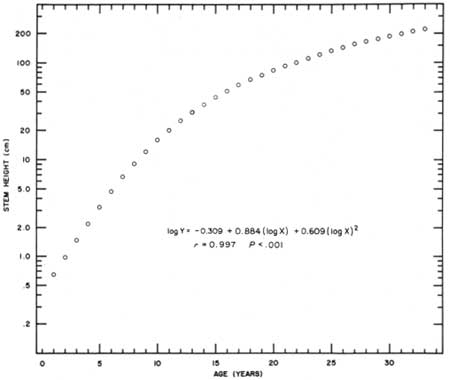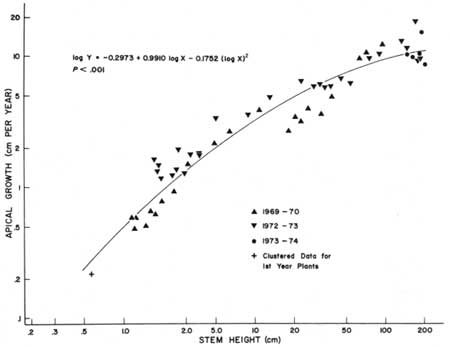|
SAGUARO
Ecology of the Saguaro: II NPS Scientific Monograph No. 8 |

|
CHAPTER 5:
GROWTH (continued)
Age and Height
The value for first-year stem height obtained by equation (1) (0.6486 cm; 0.26 inch) provides a basis for conversion of height to age for the population studied at Saguaro National Monument (east) in the saguaro habitats on flat and moderately rolling, nonrocky surface terrain. As noted above and described below, in this population the age of a very young saguaro of a given height can be determined (i.e., estimated) using the log of 0.6486 for log X in equation (2).
The saguaro growth curve for young saguaros—saguaros <2.2 m (7.2 ft) height—illustrated in Fig. 40 is described by
log Y = -0.297 + 0.991 log X -0.175 (log X)2 (2)
where Y is a one-year apical growth increment (cm) and X is the stem height (cm) for the given plant at the start of the growth-year; the associated correlation coefficient (r) is highly significant (r = +0.978, P <0.001, N = 62). As before, the data are for saguaros growing in flat land habitats at Saguaro National Monument (east) where plant-available soil moisture is relatively higher and the growth rate for most individuals is relatively faster than that for saguaros on rock outcrops and on rocky slopes with rock surfaces at Saguaro National Monument (east).
Table 28 provides age data for young saguaros (<2.2 m; 7.2 ft) at Saguaro National Monument (east) as graphed in Fig. 41. The semi-logarithmic plot of height and age (Fig. 41) is described by
log Y = -0.309 + 0.884 1og X + 0.609 (log X)2 (3)
where Y is stem height in centimeters and X is age in years; r = 0.997, P <0.001. The estimated Y (Y) values plotted in Fig. 41 were generated by using equation (2) and the on-site mean growth during the first year of life as determined by equation (1); as explained above, the calculated subsequent one-year apical growth increment for a one-year-old plant was added to the first-year height to obtain second-year stem height and, using the same stepwise procedure, stem height was calculated for each consecutive year.
Saguaros at approximately 2 m (6.6 ft) stem height undergo a marked change in growth form. The change in form is associated with a decline in growth rate and with changes in functions associated with the onset of reproduction (see Table 29; Figs. 15, 16, 38, 40, 43, 44).
Two events occur at that stage of saguaro development: (1) the plant produces its first blooms and fruits; and (2) a transition from the "club" form of the large juvenile plant to the "wine-bottle" form of the unbranched young adult as the maximum diameter ceases to follow the upward growth of the tip (Fig. 38A).
| Age (yrs) |
Apical growth (cm/yr) |
Height | |
| (cm) | (inches) | ||
| 1 | 0.32 | 0.65 | 0.26 |
| 2 | 0.49 | 0.97 | 0.38 |
| 3 | 0.73 | 1.46 | 0.58 |
| 4 | 1.07 | 2.19 | 0.86 |
| 5 | 1.43 | 3.26 | 1.27 |
| 6 | 1.94 | 4.69 | 1.85 |
| 7 | 2.51 | 6.63 | 2.61 |
| 8 | 3.11 | 9.14 | 3.60 |
| 9 | 3.75 | 12.25 | 4.82 |
| 10 | 4.38 | 16.00 | 6.30 |
| 11 | 5.01 | 20.38 | 8.02 |
| 12 | 5.61 | 25.39 | 10.00 |
| 13 | 6.18 | 31.00 | 12.20 |
| 14 | 6.72 | 37.18 | 14.64 |
| 15 | 7.20 | 43.90 | 17.28 |
| 16 | 7.66 | 51.10 | 20.11 |
| 17 | 8.09 | 58.76 | 23.13 |
| 18 | 8.46 | 66.85 | 26.31 |
| 19 | 8.82 | 75.31 | 29.64 |
| 20 | 9.14 | 84.13 | 33.11 |
| 21 | 9.44 | 93.27 | 36.71 |
| 22 | 9.71 | 102.71 | 40.43 |
| 23 | 9.96 | 112.42 | 44.25 |
| 24 | 10.18 | 122.38 | 48.17 |
| 25 | 10.40 | 132.56 | 52.18 |
| 26 | 10.58 | 142.96 | 56.27 |
| 27 | 10.76 | 153.54 | 60.43 |
| 28 | 10.92 | 164.30 | 64.67 |
| 29 | 11.07 | 175.22 | 68.97 |
| 30 | 11.20 | 186.29 | 73.32 |
| 31 | 11.33 | 197.49 | 77.73 |
| 32 | 11.45 | 208.82 | 82.21 |
| 33 | 11.55 | 220.27 | 86.72 |
As discussed earlier and illustrated in Chapter 2, some saguaros in southern Arizona and northern Sonora may start their reproductive life when only approximately 1.5 m (4.9 ft) in stem height. Ordinarily, 50% or more of the population in height-class 2.00-2.49 m (6.6-8.2 ft) flowers and produces seed during most years (Fig. 16). The tabular age of a young 1.5-m (4.9 ft) saguaro is 27 years, and the age range is approximately 31-36 years for height-class 2.00-2.49 m (6.6-8.2 ft). Our data thus estimate age of the 200 cm (6.6 ft) young saguaro at 31 years, and the 2.2 m (7.2 ft) mean stem height at 33 years age at Saguaro National Monument (east; flats and rolling terrain); see Table 28.
The data provided here together with our other field observations suggest that earlier changes in the apical growth rate of the young saguaro also are coincident with major changes in form. The data on the apical growth of young saguaros as graphed in Fig. 40 suggest that a reduction in apical growth rate may accompany the transition from the globose juvenile form to the "club" form of the large juvenile that occurs in the vicinity of 5-10 cm (2-4 inch) above-ground stem height. We anticipate answering this question in further investigations on growth rates and form changes in relation to saguaro survival and climatic adaptation.
| <<< Previous | <<< Contents >>> | Next >>> |
chap5a.htm
Last Updated: 21-Oct-2005

